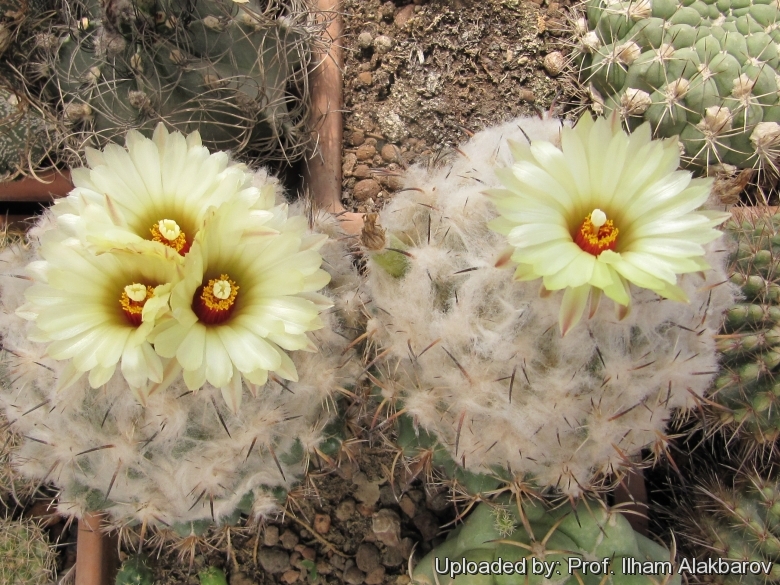




Your support is critical to our success.
Accepted Scientific Name: Coryphantha clavata (Scheidw.) Backeb.
Cactaceae (Berlin) 1941, Pt. 2, 61 (1942); cf. Gray Herb. Card Cat.

Origin and Habitat: Mexico. It is fairly widespread, occurring in the states of Aguascalientes, Guanajuato, Hidalgo, Jalisco, Querétaro, San Luis Potosí and Zacatecas. The species is particularly abundant and frequently encountered in the Rio Grande Valley.
Altitude: Around 1700-1800 metres above sea level.
Habitat and Ecology: Coryphantha clavaSN|3896]]SN|3896]]ta is commonly found in grasslands on sandy soils especially on the lower slopes of limestone and volcanic hills, usually growing under other shrubs, e.g., agaves and hechtias. The same areas support endemic succulent and xerophyte plants such as Euphorbia antisyphilitica, Jatropha spathulata, Mammillaria decipiensSN|9068]]SN|9068]], Ferocactus histrixSN|4300]]SN|4300]], Opuntia cantabrigiensisSN|32724]]SN|19939]], Opuntia imbricataSN|8157]]SN|8157]], Opuntia robustaSN|19939]]SN|32724]], Myrtillocactus geometrizansSN|8050]]SN|8050]]... and many other. Use of fire to improve grazing may be a threat in parts of the range, but overall there are no major threats.
Synonyms:
- Coryphantha clavata (Scheidw.) Backeb.
- Mammillaria clavata Scheidw.
- Neolloydia clavata Britton & Rose
Coryphantha clavata (Scheidw.) Backeb.
Cactaceae (Berlin) 1941, Pt. 2, 61 (1942); cf. Gray Herb. Card Cat.
Synonymy: 6
- Coryphantha clavata (Scheidw.) Backeb.
- Mammillaria clavata Scheidw.
- Neolloydia clavata Britton & Rose
- Coryphantha clavata var. radicantissima (Quehl) Heinrich ex Backeb.
- Coryphantha unicornis Boed.
Coryphantha clavata subs. stipitata (Scheidw.) Dicht & A.Lüthy
Cactaceae Syst. Init. 11: 12. 2001
Synonymy: 16
- Coryphantha clavata subs. stipitata (Scheidw.) Dicht & A.Lüthy
- Mammillaria stipitata Scheidw.
- Coryphantha ancistracantha (Lem.) Lem.
- Aulacothele raphidacantha ancistracantha (Lem.) Monv.
- Cactus ancistracanthus (Lem.) Kuntze
- Coryphantha clavata var. ancistracantha (Lem.) Heinrich ex Backeb.
- Coryphantha raphidacantha var. ancistracantha (Lem.) Y.Itô
- Coryphantha rhaphidacantha var. ancistracantha (Lem.) Y.Itô
- Mammillaria ancistracantha Lem.
- Mammillaria raphidacantha var. ancistracantha (Lem.) K.Schum.
- Mammillaria raphidacantha f. ancistracantha (Lem.) Schelle
- Mammillaria rhaphidacantha var. ancistracantha K.Schum.
- Coryphantha raphidacantha Lem.
- Aulacothele raphidacantha (Lem.) Monv.
- Mammillaria raphidacantha Lem.
- Mammillaria scolymoides var. raphidacantha Salm-Dyck
Description: Coryphantha clavaSN|3896]]SN|3896]]ta is an erect Coryphantha with characteristic club-shaped stems. It comprises two subspecies, the typical form and subsp. stipitata (Schweid.) Dicht & A.Lüthy.
Habit: Plants are usually solitary.
Stem: Elongate/cylindrical to clavate, 4-7 cm Ø and 10 to 30 cm high, dark blue-green, also reddish. Apex densely wooly.
Root: Turnip root
Tubercles: Distant, obliquely conical, up to 2 cm long, in rows of 5, 8 and 13. The axils when young with short white wool.
Areoles: White, with the apical (spine-bearing) and axillary parts of the areola connected by a shallow furrows above and 1-2 (or several) red large glands.
Radial spines: (6-)8-9(-12), initially brownish, base reddish with dark tips, 8–15 mm long.
Central spines: 0–1, straight, somewhat longer than radials, 20-30 mm long, yellowish to brown, usually dark banded, straight to curved or even hooked.
Flowers: Apical, variable in size, 2-5 cm long and up to 4 cm Ø, shiny pale-yellow. Outer perianth-segments linear, acute, entire, with broad brownish midrib infrequently slightly lashed; inner perianth-segments linear, entire, narrow, creamy white; stamens pinkish, much shorter than the perianth-segments; style pinkish; stigma-lobes 5 or 6, short, greenish.
Fruits: Pale-green, approx. 2 cm long.
Seeds: Brown.
Subspecies, varieties, forms and cultivars of plants belonging to the Coryphantha clavata group
 Coryphantha ancistracantha (Lem.) Lem.: Same as: Coryphantha clavata subs. stipitata
Coryphantha ancistracantha (Lem.) Lem.: Same as: Coryphantha clavata subs. stipitata Coryphantha clavata (Scheidw.) Backeb.: (subsp. clavata) Central spine straight or curved. Flowers 20-30 m in diameter. Distribution: Aguascalientes, Guanajuato, Hidalgo, Jalisco, Querétaro, San Luis Potosí and Zacatecas.
Coryphantha clavata (Scheidw.) Backeb.: (subsp. clavata) Central spine straight or curved. Flowers 20-30 m in diameter. Distribution: Aguascalientes, Guanajuato, Hidalgo, Jalisco, Querétaro, San Luis Potosí and Zacatecas. - Coryphantha clavata subs. stipitata (Scheidw.) Dicht & A.Lüthy: Central spine always hooked. Flowers 35-40 m in diameter. Distribution: Zacatecas, Guanajuato, San Luis Potosi and Jalisco, mainly around Lagos de Moreno.
Bibliography: Major references and further lectures
1) Dicht, R.F. & Lüthy, A.D. 2013. Coryphantha clavata. In: IUCN 2013. "IUCN Red List of Threatened Species." Version 2013.2. <www.iucnredlist.org>. Downloaded on 21 February 2014.
2) Edward Anderson “The Cactus family” Timber Press, Incorporated, 2001
3) James Cullen, Sabina G. Knees, H. Suzanne Cubey "The European Garden Flora Flowering Plants: A Manual for the Identification of Plants Cultivated in Europe, Both Out-of-Doors and Under Glass" Cambridge University Press, 11/Aug/2011
4) David R Hunt; Nigel P Taylor; Graham Charles; International Cactaceae Systematics Group. "The New Cactus Lexicon" dh books, 2006
5) Reto Dicht, Adrian Lüthy “Coryphantha: Cacti of Mexico and Southern USA” Springer, 14/mar/2006
6) Haustein, Erik “Der Kosmos-Kakteenführer” Franckh-Kosmos 1983
7) Nathaniel Lord Britton, Joseph Nelson Rose “Cactaceae: Descriptions and Illustrations of Plants of the Cactus Family” vol. 4 The Carnegie Institution of Washington, Washington 1923
Cultivation and Propagation: In culture Coryphantha clavaSN|3896]]SN|3896]]ta is without problems, and regularly shows its yellow flowers. It flowers quite early.
Exposition: It does best in light shade, but does well in full sun too.
Watering: It is sensitive to overwatering (rot prone).
Soils: Needs a very porous soil with good drainage.
hardiness: It tolerates fairly low temperatures as long as it is kept dry (hardy to - 5° C for short periods of time).
Propagation: Propagation is by seed.
| Your Actions | |
|---|---|
| Back to Neolloydia index | |
| Back to Cactaceae index | |
 |
Back to Cacti Encyclopedia index |
Privacy stantement - Terms and conditions - How to cite - About us - Feedback - Donate



